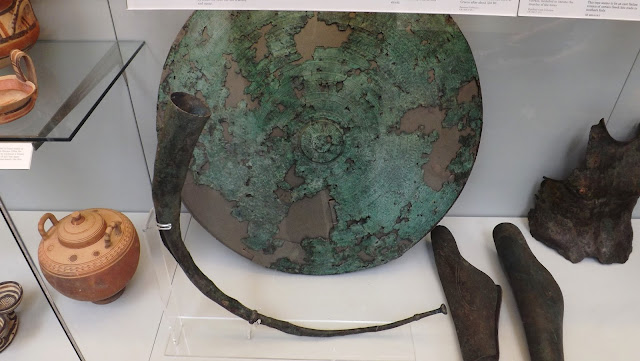 |
| Bronze Apulo-Corinthian helmet, South Italian, 400-350 BC -Ruvo, Apulia (Incised with boars and once bearing a crest and side-plumes. |
The rise of the city of Rome and it's eventual domination of the Italian peninsula is a really interesting period for the historical wargamer and covers a period where the Roman style of fighting is thought to have developed from a Greek style of hopolite warfare into the more flexible manipular system that was found to be more suitable for the rugged and mountainous terrain that characterises Italy.
The Roman army that developed was a citizen army recruited for limited service, and would develop into the force that challenged Carthage, the Successor states and others for complete domination of the Mediterranean area until the demands placed on the military demanded dramatic reforms that included a professional system of recruiting and training that would be the model for the Imperium.
The items featured in this post covers that early period of transition, including the enemies of early Rome.
The picture above and the three below illustrate the ultimate in hopolite military kit with bronze Corinthian helmet, shoulder guards, two part cuirass, greaves, and ankle guards, more likely to have been used by a horseman. The oil bottle, next to the cuirass, in the picture below shows a warrior tying the shoulder straps into place.
 |
| Pair of bronze shoulder straps for a cuirass decorated with Greeks fighting Amazons - The shoulder straps were made in Taranto about 390-340 BC, the cuirass in Southern Italy about 350-300 BC. |
 |
| The cavalryman ankle guards are from Apulia and the bronze greaves with Gorgons mouths have traces of inlaid bone in the mouth and were made in Southern Italy 550-500 BC. |
 |
| The Gorgons mouth with inlaid bone as teeth on these bronze greaves |
 |
| Chalcidian style bronze helmet from Apulia 510 BC next to a bronze horse muzzle 400-300BC also from Apulia |
 |
| Map to illustrate where the finds originate from with Apulia and the Greek influence top right |
http://jjwargames.blogspot.co.uk/2015/11/italy-2015-pisa-and-florence.html
The helmet is decorated with repousse bosses, concentric circles, helmets and birds heads.
 |
| Bronze crested helmet from Vulci, Etruria 775-750 BC |
http://www.andreaeurope.com/en/1/andrea-miniatures/111/series-general/316/sg-f57-etruscan-warrior-700-bc.html
Other types of pot helmets can be seen in the picture below. The one seen lower right is an embossed type from the Aufidus (Ofanto), Cannae and dates from 550-500 BC.
 |
| Bronze pot helmet 600 BC, found near Ancona. Type used in Picenum, Umbria and Etruria. The knobs were designed to deflect blows and the helmet would have carried a crest |
 |
| Embossed pot helmet with horse-hair crest |
Probably the Latin tribe that gave the Romans their biggest problems would be the Samnites and for those interested in recreating their forces particularly now with the advent of the superb Victrix 28mm plastics, the British Museum collection is a must see to give a good feel for the look of these warriors.
The helmet below the Montefortino type in the picture below is a Samnite Attic type from Vulci, missing its original cheek pieces, plumes and crest - 400-300 BC.
 |
| Samnite Warriors and their equipment |
Various belts and fittings can be seen in the pictures below, 400-250 BC.
The Samnite belts seen below show small perforations along the edges that were used to fix a lining to the inside.
In the picture below alongside the bronze muscled cuirass from Southern Italy 375-325 BC can be seen a very ornate bronze helmet with horse headed sea monsters, thought to be Messapian dating from 325-275 BC together with the Apulo Corinthian type shown in the header to this post.
Directly below the Messapian type helmet is a bronze Apulo-Corinthian type from Etruria dated 350-300 BC. The detail of the incised boars (Etruria is renowned for its population of wild boar and is a common device representing the territory) and herringbone pattern to the eye holes and nose piece can be seen in the next picture directly below.
 |
| Bronze Apulo-Corinthian helmet 350-300 BC with boars and herringbone pattern |
 |
| Close up of the Messapian helmet 325-275 BC |
The illustration below shows the detail of the pattern on the shield see above. Alongside the shield can be seen n Etruscan bronze trumpet dating 400-200 BC and a pair of bronze greaves from southern Italy 500-450 BC.
Below can be seen two types of Roman helmets, typical of the types used during the Punic Wars. The first dates from 220-170 BC and is missing its horse-hair plume, cheek guards, leather chin strap and possibly a felt padded lining
 |
| Punic Wars style Roman helmet 220-170 BC |
 |
| Roman Montefortino type helmet 3rd century BC |
https://en.wikipedia.org/wiki/Battle_of_Actium
 |
| Replica of a bronze head with glass/stone eyes of the Emperor Augustus 27-25 BC found at Meroe, Sudan and probably made in Egypt |
It shows the goddess Athena wearing a helmet and an aegis (shield) strapped under the arms and over the shoulders.
 |
| Prow of a boat that took part in the Battle of Actium |
In the final instalment of this series of posts on the collections in the British Museum I will look at the Ancient British and Celtic collection.














No comments:
Post a Comment